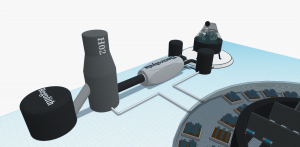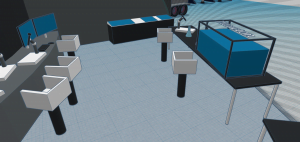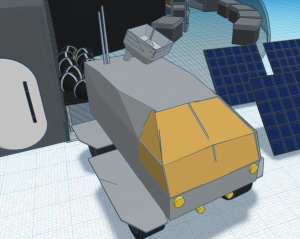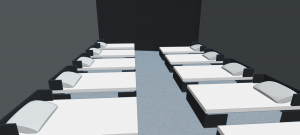Moon Camp Explorers Gallery 2020-2021
In Moon Camp Explorers each team’s mission is to 3D design a complete Moon Camp using Tinkercad. They also have to explain how they will use local resources, protect astronauts from the dangerous of space and describe the living and working facilities.
Team: Ice Breakers
Zespół Szkolny w Ładzyniu Ładzyń Poland 14
External link for 3d
|
Project description
Our base is a 10-person, fairly large research facility on the moon. The name “Copernicus” refers to Nicolaus Copernicus, the Polish astronomer who is known for formulating the Heliocentric model. Its main goal is to be as independent as possible from supplies from Earth. The cost of sending one kg from Earth to the Moon is too high to supply everything there, as is currently being done to the ISS. Therefore, our base will be partly made of lunar regolith printed by robots. The water will be extracted and then converted into oxygen and hydrogen which can be used as rocket fuel. Food will also be produced on site. Base is built above the surface, which weakens the protection against micrometeorites and radiation, but is much easier to create. The whole will help to check many solutions that can be used in the future to create a full-fledged colony on the moon. |
|||
|
Where do you want to build your Moon Camp?
Shackleton crater Why did you choose this location?
We chose this location because it provides two basic things for human survival on the moon – Electricity and Water. Due to the fact that some places are almost always sunlit, energy can be produced nearly all the time with the solar panels, and there is no need for another power source during the 14 days of lunar night as there is in places far from the poles. At the same time, there are places in the craters that contain a lot of water that can be used to plant foods and is necessary for humans. How do you plan to build your Moon Camp? Which materials would you use?
Our base will be mostly inflatable, it will save a lot of weight. Non – inflated base will land in one mission with “3d printers on wheels”. After landing, the base will inflate and the robots will begin to make an outer protective layer of lunar regolith. This use of local resources will also reduce the mass of cargo that needs to be sent to the moon. The next missions will bring items such as interior equipment, solar panels, electrolysis devices, rovers, nitrogen to breath, plants, and finally-humans. Explain how your Moon Camp will provide the astronauts with:
|
|||
|
Water
|
Food
|
Electricity
|
Air
|
|
Water will be provided by extracting it from the lunar regolith. According to some NASA estimates, the ice in the eternal darkness parts of craters may be even as high as 20%. Regolith will be collected by unmanned rovers, and H20 will be obtained from it. After filtering, it will be used for drinking, hygiene and watering plants. In addition, the water will be recycled as much as possible. These two methods will make it unnecessary to get water from Earth. |
The food also will be entirely produced in the base. Mostly potatoes and carrots will be grown there. The water will be delivered from electrolysis, the lamps will provide the lights and soil will be fertilized with human waste. Plants will also be genetically modified to make them grow faster and survive in an environment with limited access to light and water. They will be planted in such an order as to ensure continuity in their maturation, so that they do not have to be stored in large quantities while waiting for the next ones to grow. |
Energy will be mainly provided by rotating solar panels, which can produce electricity almost all the time, because near Shackleton crater at least part of the solar disc is above the horizon all the time. Unfortunately, there may still be temporary interruptions in the production of electricity, for example due to the covering of the sun by the Earth or base. At these times, energy will be obtained from fuel cells powered by oxygen and hydrogen obtained from the electrolysis of water. The water produced in reaction will be transported back into the tank. |
The air will have a similar composition to the Earth’s atmosphere – about 22% oxygen and 78% nitrogen. In addition, there will also be minor amounts of other gases such as CO2 and water vapor. Since oxygen is consumed in many processes, it will be produced by electrolysis and replenished. Since nitrogen in the air will not be consumed, it will not be produced. At the beginning, it will be delivered, and its small losses (resulting from, for example, imperfections of the airlock or leaks) will be replenished with small supplies from Earth. |
|
Describe a day on the Moon for one of your Moon Camp astronauts
Copernicus Moon Base, like most space infrastructure, will use UTC (London time). A typical working day will begin in the morning around 6:00 a.m. Astronauts have an hour for personal hygiene and breakfast. At 7:00 a.m., a briefing begins, during which the Commander, together with the Mission Control Center on Earth, assigns the astronauts specific tasks, both scientific and related to station maintenance. If the base does not require immediate repair, most of the crew do the scientific work in the lab for the next few hours. Around 12:00 p.m., there is a half-hour lunch break. After that, there is time for maintenance of the station, farm, cleaning etc. The length of this part strongly depends on the condition of the station, although usually it should not last longer than 3 hours. Then the crew continues their scientific work until 6:30 p.m. When they are done, they report to the Mission Control Center. After that, the astronauts work out in the gym for about an hour to keep their bones and muscles in good condition. When they are done, they have dinner, followed by free time at around 8:00 p.m. Then the crew can contact their families, read or listen to something, watch movies etc. This plan may change if a longer moonwalk is planned, crew changes occur, or a critical element of the base needs repair. |
|||


















